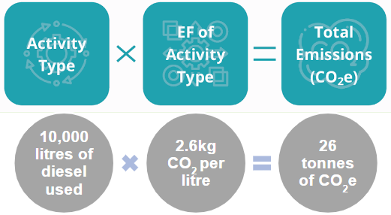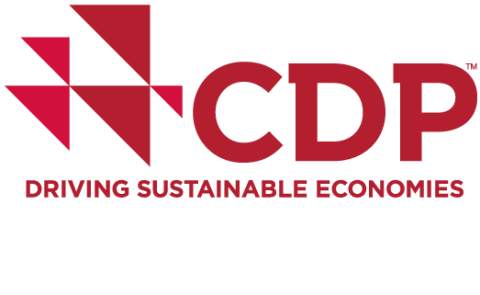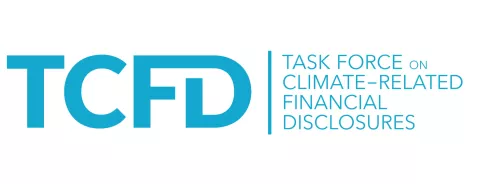Simplified Steps for Creating Your First GHG Inventory
1. Set Organizational Boundaries
When determining how to report emissions, companies typically choose from three approaches: Operational Control, Financial Control, and Equity Share. Operational Control is straightforward and recommended for most SMEs, focusing on operations where the company has authority to make and implement policies. Financial Control relates to the ability to make financial and operational decisions for profit, while Equity Share allocates emissions based on the company’s equity stake in each operation, with a higher share indicating greater responsibility for emissions. For most SMEs, Operational Control is the most relevant, encompassing emissions from both owned and leased properties.
Reminder: for more detailed instructions, please check out our video
2. Map Out Business Activities
Mapping involves identifying and documenting the specific sources of fuel and energy utilized across various sites within your operations. The ultimate objective is to comprehensively understand all the fuel and energy sources employed at each site. This understanding forms the foundation for effectively collecting accurate data on carbon emissions and energy usage throughout your organization.
Here is an example of a company’s supply chain and the associated emission categories:
3. Select Data Sources
When conducting carbon accounting, SMEs rely on two primary types of data: activity-based and spend-based. Activity-based data, preferred for its direct measurement of operational activities such as energy consumption and transportation, provides precise metrics in physical units (e.g., kilowatt-hours, kilometers driven) crucial for calculating emissions accurately. In contrast, spend-based data focuses on financial transactions related to purchased goods and services, offering insights into indirect emissions and supply chain impacts through procurement records and expenditure details.
Here are some examples of data sources for scope 1 emissions.
| Source type | Definition | Collection of data and inputs |
|---|---|---|
| Stationary combustion | Combustion of fuels in stationary equipment such as boilers, furnaces, burners, turbines, heaters, incinerators, engines, flares, etc. | Data are often provided by the utility company that supplies the fuel to the organization. A monthly natural gas bill, for example, can be used to provide information regarding how much natural gas was purchased for the previous billing cycle. |
| Mobile sources | Combustion of fuels in transportation devices such as automobiles, trucks, buses, trains, airplanes, boats, ships, barges, vessels, etc. | Data sources vary, but fuel usage is often determined from fuel receipts or purchase records, and mileage can be determined from vehicle records. |
| Fugitive emissions | Emissions generated by intentional or unintentional releases. This category includes refrigerant leakage from fire suppression equipment and air conditioners during use, maintenance, and/or disposal of the device. | Data for these sources is often collected from maintenance and inspection records, work orders, or invoices from contractors that service this equipment. |
Source: BDC, GHG Protocol
4. Find Appropriate Emission Factors
Emission factors represent the amount of greenhouse gas emissions produced per unit of activity, helping organizations calculate and report their environmental impact accurately. Some reliable sources of data include Environment and Climate Change Canada and the National Inventory Report.
In Canada, emission factors vary significantly from one province to another, hence the importance of taking into account the location of the SME. For businesses in British Columbia, localized emission factors may be found in the B.C. Best Practices Methodology for Quantifying Greenhouse Gas Emissions published by the province’s Ministry of Environment and Climate Change Strategy in 2021.
5. Calculate GHG Emissions
When using excel, emissions data should be calculated using a tabular format with rows representing each calculated emissions data point, and columns containing details on data point.
For more detailed instructions, please check out our video
Ecopest
Who is EcoPest?
EcoPest Inc. is a major player in the pest control industry, offering a range of services from fumigation to pesticide manufacturing across Western Canada. The company aims to quantify and manage its environmental impact in line with global trends and client expectations.
What are the challenges that EcoPest faced?
In attempting to calculate its environmental impacts, EcoPest Inc. encountered several challenges:
- The company's multifaceted operations lacked a clear quantification of carbon emissions, hindering the identification of specific environmental impacts.
- Without a standardized methodology, EcoPest struggled to establish a reliable and accurate emissions reporting protocol.
- The complexity of translating raw emissions data into practical reduction strategies posed a significant obstacle, compounded by the company's limited experience in this area.
How did the Climate Clinic help?
EcoPest, in collaboration with the SME Climate Clinic, developed a multifaceted response to tackle these challenges:
- They utilized Breeze carbon accounting software as a central tool to create a detailed inventory of greenhouse gas emissions from all significant sources.
- The Climate Clinic team adopted the globally recognized GHG protocol, categorizing emissions into Scope 1 and 2, and identifying hotspots for Scope 3, ensuring a comprehensive emissions profile.
- A robust data analysis process was implemented to translate complex financial and operational information into clear carbon emission figures. This step was crucial for pinpointing areas of the business with the highest emissions and strategizing ways to reduce them.
What are the results of the analysis?
The comprehensive methodology adopted by EcoPest, with support from the SME Climate Clinic, led to a thorough analysis of the company's carbon footprint. The findings revealed how emissions are distributed across the organization's operations and underscored that a significant portion of the emissions stemmed from Scope 1 activities.
With a wide service network across Western Canada, EcoPest's fleet of service vehicles emerged as the main source of direct emissions. This insight highlighted a critical area for emissions reduction efforts and marked the beginning of EcoPest’s journey in carbon accounting.
What are the next steps?
The next steps include addressing other emissions sources, especially Scope 3 emissions in EcoPest’s value chain, and setting emission reduction targets and initiatives. Examining EcoPest’s waste management and chemical use practices is also crucial for a comprehensive environmental assessment.
As these efforts progress, EcoPest will improve its ability to communicate environmental impact to stakeholders. With growing consumer and regulatory demands for transparency, EcoPest is ready to expand on this initial assessment, supported by ongoing assistance from the SME Climate Clinic to drive impactful change.
| CDP (Carbon Disclosure Project) | CDP (Carbon Disclosure Project) runs a disclosure system for companies to manage their environmental impacts. In April 2024, CDP rolled out a dedicated SME corporate questionnaire. The questions will be aligned to the CDP full corporate questionnaire, but with fewer data points, simplified question formats and enhanced guidance to ease SMEs’ reporting burden. | |
| GRI (Global Reporting Initiative) | GRI is one of the most widely used frameworks for sustainability reporting globally. It offers comprehensive guidelines for reporting on economic, environmental, and social aspects of sustainability, aiming to promote transparency and accountability. | |
| Sustainability Accounting Standards Board (SASB) | SASB provides industry-specific sustainability accounting standards, focusing on financially material sustainability topics that are likely to impact the financial performance of companies within each industry. | |
| Task Force on Climate Related Disclosures (TCFD) | TCFD (Task Force on Climate-related Financial Disclosures) was created to offer guidelines for voluntary climate-related financial reporting. Its four-pillar framework provides a practical foundation for businesses to systematically develop and implement their sustainability strategies. | |
| International Financial Reporting Standards (IFRS) S1 and S2 | IFRS S1 and S2 are part of the International Financial Reporting Standards (IFRS) framework and focus on incorporating climate-related disclosures into financial reporting. Following IFRS S2, an entity is required to disclose scope 3 greenhouse gas emissions in accordance with the standard. |
ESG Centre of Excellence
- One-on-one assistance to help organizations navigate the ESG landscape
- Support decision making and highlight key practices for your industry
- Facilitate connections to experts, educators, and resources
1. Contact us
Reach out through the contact us page, and let us know your interest in ESG advisory services.
2. ESG self-assessment
Complete the 20-minute ESG Self-assessment Form to identify your ESG maturity.
3. One-on-one discussion
Meet with our advisory services team and receive tailored ESG support.
4. Access tools and resources
Get exclusive access to tools and resources that will support your ESG journey, including primers on materiality and reporting.
5. Ongoing support
We’re here for you, whether you are simply curious, want to learn about ESG or start taking actions.
6. Share your progress
Your feedback is valuable for continuous improvement.
BDC
- Initiative aimed at supporting Canadian businesses in their efforts to mitigate climate change and transition to a low-carbon economy.
- Provides resources, tools, and financing solutions to help businesses reduce their carbon footprint, adopt clean technologies, and improve their sustainability practices.
Vancity
Vancity has teamed up with Synergy Enterprises to crease an emissions calculator and workbook. This tool has been created to help SMEs improve their understanding of their emissions impact, get an idea of what activities are included in their scope 1 and 2 GHG emissions, and identify their top emissions sources.
The SME Climate Hub is a non-profit global initiative that empowers small to medium sized companies to take climate action and build resilient businesses for the future. Through their website you can access helpful tools and resources in order to:
Calculate your business emissions
See how your business can start taking meaningful action.
Take action to reduce your emissions
The SME Climate Hub action Guides and Courses outline how companies can reduce their emissions across all scopes.
Report your progress
The SME Reporting Tool enables committed SMEs to report on their emissions.
Watch our video on SME Climate Hub’s Climate Fit Training here

-
Have a question?
Our team is happy to help.















